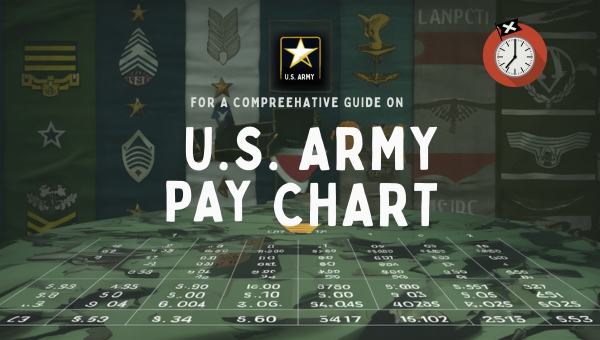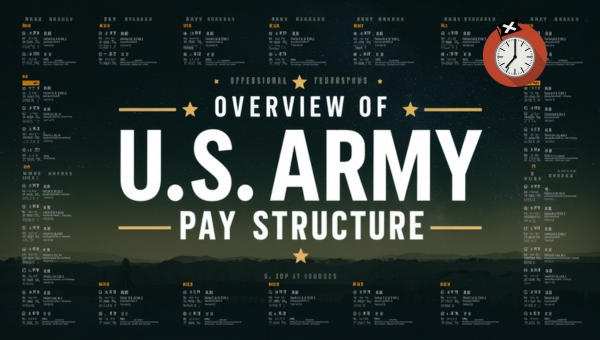U.S. Army and Military Pay Chart | Complete Guide

It can be difficult to navigate the U.S. Army and military pay chart, but knowledge of it is essential for service members and their families. This piece will examine the components that make up military pay, including base pay, variables that affect pay, and supplementary perks.
We’ll also break down the pay charts for enlisted soldiers, officers, and warrant officers. Moreover, you’ll learn about various allowances and retirement benefits that add significant value to military careers. By the end, you’ll have a comprehensive understanding of how pay works in the U.S. Army, empowering you to make informed financial decisions.
Overview of U.S. Army Pay Structure
Understanding the U.S. Army pay structure can be a bit complex, but it’s essential for those considering a military career or those who are simply curious.

This pay structure includes various components that collectively determine the total compensation for service members. Let’s delve into the basics of base pay, explore the factors affecting pay, and outline additional types of compensation that soldiers receive.
Base Pay and Salary
Base pay is the fundamental component of military compensation. It is the fixed amount of money that a service member receives monthly and is determined primarily by their rank and years of service.
Here’s how it works:
- Rank: Each rank in the military has a corresponding pay grade, starting from E-1 (the lowest enlisted rank) to O-10 (the highest officer rank). Each pay grade has a specified base pay amount.
- Years of Service: As service members gain experience and serve longer durations, they move up in pay grades. For example, an E-3 with three years of service earns more than an E-3 with one year of service.
Base pay forms the backbone of military compensation, but it’s important to note that it represents only a part of the total pay package. Additional allowances and incentives further enhance overall earnings.
Factors Affecting Pay
Several factors influence the pay that U.S. Army personnel receive. These factors ensure that the compensation is equitable and reflects the service member’s role, experience, and circumstances.
Key factors include:
- Rank: Higher ranks come with increased responsibilities and thus higher pay grades.
- Years of Service: Longevity in service translates to higher pay, rewarding experience and dedication.
- Deployment Status: Service members deployed to combat zones or other hazardous areas often receive additional pay to compensate for the increased risk and hardship.
These factors collectively ensure that pay is tailored to reflect the unique contributions and sacrifices of each service member.
Additional Types of Compensation
Beyond base pay, the U.S. Army provides various additional forms of compensation to address specific needs and circumstances.
These include:
- Allowances: These are non-taxable payments designed to cover specific needs like housing and food. Common allowances include the Basic Allowance for Housing (BAH) and the Basic Allowance for Subsistence (BAS).
- Bonuses: The Army offers enlistment and re-enlistment bonuses to attract and retain personnel in critical or understaffed roles.
- Special Pay: Certain roles and duties come with special pay. For instance, hazardous duty pay, flight pay, and sea pay are provided to those in particularly challenging or risky positions.
These additional types of compensation ensure that service members are adequately supported in their roles, contributing to overall job satisfaction and retention.
U.S. Army and Military Pay Chart Breakdown
Understanding the pay structure in the U.S. Army is crucial for anyone considering a military career. The pay chart differs significantly based on rank, experience, and specific roles. Let’s explore the details of enlisted pay, officer pay, and warrant officer pay to provide a comprehensive understanding of how these categories differ.

Enlisted Pay Chart
Enlisted soldiers form the backbone of the U.S. Army, and their pay scales range from E-1 to E-9. Here’s how it breaks down:
- E-1 (Private): The starting point for new recruits, with base pay starting around $1,733.10 per month.
- E-2 (Private Second Class): After basic training, pay increases to approximately $1,943.40 per month.
- E-3 (Private First Class): With more experience, the monthly pay rises to about $2,043.60.
- E-4 (Specialist/Corporal): Pay increases further to around $2,263.20 monthly.
- E-5 (Sergeant): With leadership roles, pay starts at approximately $2,468.40 per month.
- E-6 (Staff Sergeant): Monthly pay increases to about $2,694.00.
- E-7 (Sergeant First Class): Experienced soldiers earn around $3,114.30 per month.
- E-8 (Master Sergeant/First Sergeant): Higher ranks see a pay rise to approximately $4,480.20 monthly.
- E-9 (Sergeant Major): Top enlisted soldiers earn about $5,472.90 per month.
Each rank comes with incremental pay raises based on years of service, ensuring a steady income growth.
Officer Pay Chart
Commissioned officers, ranging from O-1 to O-10, have a different pay structure from enlisted soldiers.
Here’s how it works:
- O-1 (Second Lieutenant): Starting monthly pay is around $3,385.80.
- O-2 (First Lieutenant): Pay increases to approximately $3,901.20 per month.
- O-3 (Captain): Monthly pay rises to about $4,514.70.
- O-4 (Major): With more experience, pay is around $5,135.10 per month.
- O-5 (Lieutenant Colonel): Monthly pay increases to approximately $5,951.40.
- O-6 (Colonel): Pay rises to about $7,139.10 per month.
- O-7 (Brigadier General): Higher ranks see pay increase to around $9,140.10 monthly.
- O-8 (Major General): Pay is approximately $11,794.80 per month.
- O-9 (Lieutenant General): Monthly pay rises to about $16,444.80.
- O-10 (General): The highest rank with pay starting around $16,975.20 per month.
Officers typically receive higher pay than enlisted soldiers, reflecting their leadership responsibilities and advanced education.
Warrant Officer Pay Chart
Warrant officers bridge the gap between enlisted soldiers and commissioned officers, specializing in technical fields.
Here’s their pay structure:
- W-1 (Warrant Officer 1): Starting monthly pay is approximately $3,399.00.
- W-2 (Chief Warrant Officer 2): Pay increases to about $3,918.60 per month.
- W-3 (Chief Warrant Officer 3): With more experience, pay rises to around $4,586.70 monthly.
- W-4 (Chief Warrant Officer 4): Monthly pay increases to about $5,408.40.
- W-5 (Chief Warrant Officer 5): The highest warrant officer rank earns around $6,536.70 per month.
Warrant officers’ pay reflects their specialized skills and experience, distinguishing them from both enlisted soldiers and commissioned officers.
Understanding these pay charts is essential for anyone looking to embark on a military career, providing clear insight into how compensation grows with rank and experience.
Benefits and Allowances in Addition to Base Pay
Military personnel receive more than just a salary. Various benefits and allowances significantly enhance their overall compensation package.

These additional perks are designed to support service members in different aspects of their lives, making their financial stability more robust. Below, we’ll dive into three primary allowances: Basic Allowance for Housing (BAH), Basic Allowance for Subsistence (BAS), and Special Pay and Incentives.
Basic Allowance for Housing (BAH)
Basic Allowance for Housing (BAH) is a non-taxable benefit provided to military personnel to help cover housing costs.
It is calculated based on:
- Location: Housing costs vary widely by geographic area. BAH rates are adjusted to reflect these differences.
- Rank: Higher ranks typically receive higher allowances.
- Dependency Status: Service members with dependents receive a higher BAH than those without.
BAH ensures that military personnel can afford suitable housing without dipping too much into their base pay. This allowance covers rent or mortgage payments, making it easier for service members to secure housing that meets their needs.
Basic Allowance for Subsistence (BAS)
Basic Allowance for Subsistence (BAS) is another key component of military compensation. This allowance is designed to help cover food costs.
It is calculated based on:
- Enlisted or Officer Status: Different rates are set for enlisted personnel and officers.
- Annual Adjustments: BAS rates are adjusted annually to reflect changes in food prices.
BAS provides a monthly stipend that can be used for groceries and meals, ensuring that service members have the financial means to maintain a healthy diet.
Special Pay and Incentives
In addition to BAH and BAS, military personnel may receive various types of special pay and incentives. These are designed to compensate for unique duties or challenging conditions.
Some examples include:
- Hazardous Duty Pay: For roles involving significant risk, such as explosive ordnance disposal or parachuting.
- Flight Pay: For personnel involved in aviation, including pilots and flight crew.
- Deployment Bonuses: Additional compensation for service members deployed to combat zones or other high-stress areas.
These special pays and incentives recognize the unique challenges and risks faced by military personnel, providing them with financial rewards for their dedication and service.
Understanding Military Retirement Pay
Navigating the realm of military retirement pay can seem daunting, but we’ve got you covered. Whether you’re a current service member or considering a military career, understanding how retirement pay works is crucial. Let’s take a deep dive into the essentials of military retirement pay, beginning with eligibility criteria, moving on to the Blended Retirement System, and finally exploring the benefits that come after retirement.
Pension Eligibility
Pension eligibility in the military is determined by a few key factors. Here’s what you need to know:
- Years of Service: Typically, service members must complete at least 20 years of active duty to be eligible for retirement pay.
- Retirement Points: For reservists, eligibility is based on accruing retirement points through drills, training, and active duty periods.
- High-3 Average: The retirement pay is calculated based on the average of the highest 36 months of basic pay earned during a service member’s career.
- Final Pay Method: For those who joined before September 8, 1980, the final pay method uses their last basic pay amount to calculate the pension.
Blended Retirement System (BRS)
The Blended Retirement System (BRS) is a modern approach to military retirement benefits, impacting how future pensions and savings are managed:
- Defined Benefit: This is similar to the traditional pension, providing a monthly retirement pay based on the years of service and the high-3 average.
- Defined Contribution: In addition to the pension, the BRS includes contributions to the Thrift Savings Plan (TSP), a retirement savings account.
- Matching Contributions: The military matches contributions to the TSP up to 5% of the service member’s basic pay.
- Continuation Pay: At the midpoint of their career, service members may receive a one-time, mid-career bonus to incentivize continued service.
Benefits After Retirement
Retiring from the military comes with a suite of additional benefits that extend beyond just the pension:
- Healthcare: Retirees and their families can access healthcare services through TRICARE, which provides comprehensive medical coverage.
- Commissary and Exchange Privileges: Retirees retain access to military commissaries and exchanges, allowing them to purchase goods at discounted prices.
- Life Insurance: Various life insurance options are available to retirees, ensuring financial security for their families.
- Space-Available Travel: Retirees can take advantage of space-available travel on military aircraft, offering a cost-effective way to travel.
Understanding these components will help you make informed decisions about your future, ensuring you can maximize the benefits you’ve earned through your service.
FAQs
How often does military pay increase?
Military pay typically increases annually. The adjustments are usually based on the Employment Cost Index to match inflation and cost of living.
Can military pay be adjusted for inflation?
Yes, military pay can be adjusted for inflation. Annual cost-of-living adjustments are made to ensure compensation keeps pace with inflation rates.
Are military bonuses taxable?
Yes, military bonuses are generally taxable. However, certain exemptions may apply if the service member is in a combat zone.
Conclusion
Understanding the U.S. Army and military pay chart is crucial for both service members and those considering a military career. From the structure of base pay to the various allowances and special pay options, each component plays a significant role in overall military compensation.
Furthermore, the benefits and retirement plans provide long-term financial security for military personnel. By comprehensively exploring these aspects, you can make informed decisions about your military career path. If you found this article helpful, be sure to explore more insightful content on our site! Your journey to understanding military life starts here.





